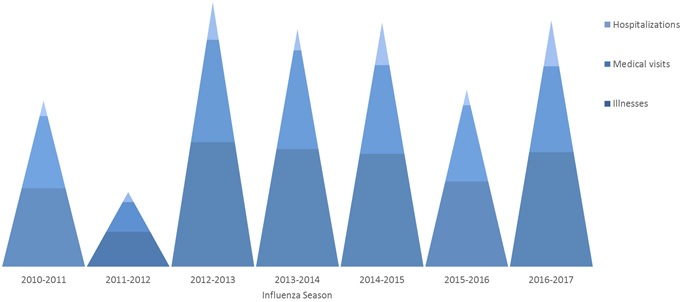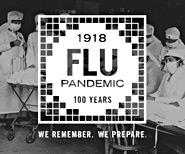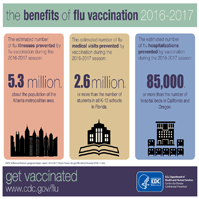Estimated Influenza Illnesses, Medical visits, and Hospitalizations Averted by Vaccination in the United States
On This Page
- 2016-2017 Estimates
- Conclusion
- Limitations
- 2016-2017 Tables
- Table 1: 2016-17 Burden, by Age
- Table 2: All Seasons Burden, Overall
- Table 3: 2016-17 Averted Outcomes, by Age
- Table 4: All Seasons Averted Outcomes, Overall
- Table 5: Vaccine Coverage and Effectiveness Estimates, by Age
- Figure 1: Pyramid with Cases, Medically-attended, Hospitalizations
- Figure 2: Schematic Diagram Describing Estimation of Community Illness and Outpatient Medical Visits
- Questions & Answers
- References
- Burden Averted Infographic
This web page provides estimates on the burden of influenza and the impact of annual influenza vaccination in the United States for the 2016–2017 influenza season.
For the past several years, CDC has used a model to estimate the numbers of influenza illnesses, medical visits, hospitalizations, and the impact of influenza vaccination on these numbers in the United States (1-5). The methods used to calculate the estimates have been described previously (1,2) and are outlined briefly below. CDC uses the estimates of the burden of influenza in the population and the impact of influenza vaccination to inform policy and communications related to influenza.
2016–2017 Estimates
Influenza activity in the United States during the 2016–2017 season began to increase in December and peaked in mid-February (6). While influenza A(H3N2) viruses predominated through mid-March, and were predominant overall for the season, influenza B viruses were more commonly reported from late March through May. The season was notable because of high hospitalization rates, particularly among adults aged 50–64 years and ≥65 years. Overall and for all ages, hospitalization rates were similar to the rates observed during the 2012–2013 and 2014–2015 seasons, both of which were influenza A(H3N2)-predominant seasons characterized with “high” severity among older adults (7).
These high hospitalization rates equated with a substantial influenza burden of illness during the 2016–2017 season with an estimated 30.9 million people getting sick with influenza, 14.5 million going to a health care provider for influenza, and an estimated 600,000 people being hospitalized from influenza (see Table 1). Overall, the burden estimates for last season were approximately as high as the estimated burden for 2012–2013 and 2014–2015 seasons (see Figure 1 & Table 2).
The number and proportion of influenza-associated hospitalizations prevented by vaccination during 2016–2017 varied by age group, due to age-specific differences in influenza burden, vaccine coverage, and vaccine effectiveness. Vaccination prevented the lowest proportion of illnesses among adults aged 18 to 49 years, who had the lowest vaccine coverage, and adults aged ≥65 years, who had higher vaccine coverage but the lowest vaccine effectiveness. Vaccination prevented the greatest proportion of outcomes among children aged 6 months to 4 years and 5 to 17 years, where the burden of influenza illness and medical visits was high and the vaccine effectiveness was greatest.
How can we reduce influenza illness?
Improvements in vaccine coverage could provide a greater public health benefit. For example, if vaccination rates increased by just 5 percentage points across the entire population, another 483,000 illnesses, 232,000 medical visits, and 6,950 hospitalizations associated with influenza could be prevented. If vaccination rates improved to the Healthy People goal of 70% for all age groups, another 1.89 million illnesses, 822,000 medical visits, and 17,300 hospitalizations could have been prevented during the 2016-2017 influenza season.
Strategies to improve vaccine coverage include ensuring influenza vaccination status is assessed at each heath care encounter during the influenza season (October through May), ensuring patients receive a recommendation to get vaccinated and an offer of vaccination from their provider, using standing orders in the health care office, using patient reminder/recall systems aided by immunization information systems, and expanding vaccination access through use of nontraditional settings for vaccination (e.g., pharmacies, workplaces, and schools) to reach persons who might not visit a physician’s office during the influenza season.
Similarly, improvements to vaccine effectiveness could provide incremental public health benefit. Several efforts are currently underway to understand and investigate factors that contribute to reduced or increased vaccine effectiveness and these are described further by Flannery, et al. (9). In brief, higher vaccine effectiveness may be seen with different vaccine production methods or formulations, including higher doses of antigen or the additional of adjuvants to stimulate the immune response.
Conclusion
CDC estimates that influenza vaccination during the 2016–2017 influenza season prevented an estimated 5.29 million illnesses, 2.64 million medical visits, and 84,700 hospitalizations associated with influenza. This report underscores the benefits of the current vaccination program, but also highlights areas where improvements in vaccine uptake and vaccine effectiveness could deliver even greater benefits to the public’s health. For example, increasing vaccination coverage among working-age adults younger than 65 years would further reduce the burden of influenza, as this age group continues to have the lowest influenza vaccination coverage.
Limitations
These estimates are subject to several limitations. First, influenza vaccination coverage estimates were derived from reports by survey respondents, not vaccination records, and are subject to recall bias. These coverage estimates are based on telephone surveys with relatively low response rates; nonresponse bias may remain after weighting for the survey design. Estimates of the number of persons vaccinated based on these survey data have often exceeded the actual number of doses distributed, indicating that coverage estimates used in this report may overestimate the numbers of illnesses and hospitalizations averted by vaccination. The model of averted illness calculates outcomes directly prevented among persons who were vaccinated. If there is also indirect protection from decreased exposure to infectious persons in a partially vaccinated population (i.e., herd immunity), the model would underestimate the number of illnesses and hospitalizations prevented by vaccination. Estimates of the averted burden in older adults, aged ≥65 years, do not reflect the increasing use of high-dose or adjuvanted influenza vaccines, which may have higher effectiveness compared with standard vaccines; nor does the estimate reflect that vaccine effectiveness might continue to decrease with age, reaching very low levels among the oldest adults who also have the highest rates of influenza vaccination. Finally, because the data and methods used to make these calculations are continually updated, future estimates may differ from those presented here.
Previous Estimates
Previous estimates of the burden of illness, medical visits, and hospitalizations related to influenza are available online and in scientific publications (1-5). Estimates using the same methodology as for the 2016-2017 season are shown in the tables below to provide context for the current season’s estimates.
Top of Page2016-2017 Tables for Influenza Burden and Burden-Averted Estimates
Top of Page Top of Page Top of Page Top of Page*Estimates from FluVaxView. (10)
†Estimates from US Flu VE Network. (11)
Top of PageFigure 1: Estimates of Influenza-associated Illness, Medical Visits, and Hospitalizations — United States, 2010–2011 to 2016–2017 Influenza Seasons
 Top of Page
Top of PageFigure 2: Schematic Diagram Describing Estimation of Community Illness and Outpatient Medical Visits Associated Influenza Starting with Crude Hospitalization Rates From FluSurv-NET — United States, 2016–2017 Influenza Season

1 Reed C, Chaves SS, Daily Kirley P, et al. Estimating influenza disease burden from population-based surveillance data in the United States. PLoS One 2015;10:e0118369.
2 Reed C, Angulo FJ, Swerdlow DL, et al. Estimates of the prevalence of pandemic (H1N1) 2009, United States, April-July 2009. Emerg Infect Dis 2009;15:2004-7.
3 Biggerstaff M, Jhung M, Kamimoto L, Balluz L, Finelli L. Self-reported influenza-like illness and receipt of influenza antiviral drugs during the 2009 pandemic, United States, 2009-2010. Am J Public Health 2012;102:e21-6.
Top of PageQuestions & Answers
How does CDC estimate the number of hospitalizations, illnesses, and medically-attended illnesses associated with influenza that occurred in the United States?
Laboratory-confirmed influenza-associated hospitalization rates by age group were obtained from FluSurv-NET, a collaboration between CDC, the Emerging Infections Program Network, and selected state and local health departments in 13 geographically distributed areas in the United States that conduct population-based surveillance. Reported hospitalization rates were adjusted using a multiplier to correct for underreporting, which is calculated from the percent of persons hospitalized with respiratory illness who were tested for influenza and the average sensitivity of influenza tests used in the surveillance hospitals (Figure 2). These values were measured from data collected during four post-pandemic seasons; data from two seasons were previously reported (2).
Adjusted rates were applied to the U.S. population by age group to calculate the numbers of influenza-associated hospitalizations. The numbers of influenza illnesses were then estimated from hospitalizations based on previously measured ratios that reflect the estimated number of ill persons per hospitalization in each age group (5).
The numbers of persons seeking medical care for influenza were then calculated using age group-specific data on the percentages of persons with a respiratory illness who sought medical care, which were estimated from results of the 2010 Behavioral Risk Factor Surveillance Survey (12).
All estimates were rounded to three significant digits.
How does CDC estimate the number of influenza-associated outcomes that were prevented with influenza vaccination?
The annual estimates of influenza vaccination coverage by month during each season and the final end-of-season vaccine effectiveness measurements were used to estimate how many persons were not protected by vaccination during the season and thus were at risk for these outcomes.
The rate of each outcome among persons at risk was then used to estimate the number of influenza-associated outcomes that would have been expected in the same population if no one had been protected by vaccination. Finally, the averted outcomes attributable to vaccination were calculated as the difference between outcomes in the hypothetical unvaccinated population and the observed vaccinated population.
Estimates of 2016–2017 influenza vaccination coverage by month from July 2016 through April 2017, were based on self-report or parental report of vaccination status using data from the National Immunization Survey for children aged 6 months-17 years and Behavioral Risk Factor Surveillance Survey data for adults aged ≥18 years (10).
Vaccine effectiveness estimates for the 2016–2017 season were derived from the US Influenza Vaccine Effectiveness Network, a group of five academic institutions that conduct annual vaccine effectiveness studies. (11) The network estimates the effectiveness of vaccination for preventing real-time reverse transcription polymerase chain reaction-positive influenza among persons with acute respiratory illness of ≤7 days duration seen in hospitals, emergency departments, or outpatient clinics in communities in four states.
Calculations were stratified by month of the year to account for annual variations in the timing of disease and vaccination and then summed across the whole season. The prevented fraction was calculated as the number of averted illnesses divided by the total illnesses that would have been expected in an unvaccinated population.
All estimates were rounded to three significant digits.
Top of PageReferences
- Kostova D, Reed C, Finelli L, Cheng PY, Gargiullo PM, Shay DK, et al. Influenza Illness and Hospitalizations Averted by Influenza Vaccination in the United States, 2005-2011. PLoS One. 2013;8(6):e66312.
- Reed C, Chaves SS, Daily Kirley P, Emerson R, Aragon D, Hancock EB, et al. Estimating influenza disease burden from population-based surveillance data in the United States. PLoS One. 2015;10(3):e0118369.
- Centers for Disease Control and Prevention. Estimated influenza illnesses and hospitalizations averted by influenza vaccination – United States, 2012-13 influenza season. MMWR Morb Mortal Wkly Rep. 2013 Dec 13;62(49):997-1000.
- Reed C, Kim IK, Singleton JA, Chaves SS, Flannery B, Finelli L, et al. Estimated influenza illnesses and hospitalizations averted by vaccination–United States, 2013-14 influenza season. MMWR Morb Mortal Wkly Rep. 2014 Dec 12;63(49):1151-4.
- Centers for Disease Control and Prevention. Estimated Influenza Illnesses and Hospitalizations Averted by Vaccination — United States, 2014–15 Influenza Season. 2015 December 10, 2015 [cited 2016 October 27]; Available from: http://www.cdc.gov/flu/about/disease/2014-15.htm
- Blanton L, Alabi N, Mustaquim D, Taylor C, Kniss K, Kramer N, et al. Update: Influenza Activity in the United States During the 2016-17 Season and Composition of the 2017-18 Influenza Vaccine. MMWR Morb Mortal Wkly Rep. 2017 Jun 30;66(25):668-76.
- Biggerstaff M, Kniss K, Jernigan DB, Brammer L, Bresee J, Garg S, et al. Systematic Assessment of Multiple Routine and Near-Real Time Indicators to Classify the Severity of Influenza Seasons and Pandemics in the United States, 2003-04 Through 2015-2016. Am J Epidemiol. 2017 Oct 19.
- Zimmerman RK, Nowalk MP, Chung J, Jackson ML, Jackson LA, Petrie JG, et al. 2014-2015 Influenza Vaccine Effectiveness in the United States by Vaccine Type. Clin Infect Dis. 2016 Dec 15;63(12):1564-73.
- Flannery B, Chung JR, Belongia EA, McLean HQ, Gaglani M, Murthy K, et al. Interim Estimates of 2017-18 Seasonal Influenza Vaccine Effectiveness – United States, February 2018. MMWR Morb Mortal Wkly Rep. 2018 Feb 16;67(6):180-5.
- Centers for Disease Control and Prevention. Flu Vaccination Coverage, United States, 2016-17 Influenza Season. September 28, 2017 [cited 2017 August 29]; Available from: https://www.cdc.gov/flu/fluvaxview/coverage-1617estimates.htm
- Centers for Disease Control and Prevention. Seasonal Influenza Vaccine Effectiveness, 2005-2017. 2018 January 4, 2018 [cited 2018 January 12]; Available from: https://www.cdc.gov/flu/professionals/vaccination/effectiveness-studies.htm
- Biggerstaff M, Jhung M, Kamimoto L, Balluz L, Finelli L. Self-reported influenza-like illness and receipt of influenza antiviral drugs during the 2009 pandemic, United States, 2009-2010. Am J Public Health. 2012 Oct;102(10):e21-6.
- Page last reviewed: April 2, 2018
- Page last updated: May 22, 2018
- Content source:
- Centers for Disease Control and Prevention, National Center for Immunization and Respiratory Diseases (NCIRD)
- Page maintained by: Office of the Associate Director for Communication, Digital Media Branch, Division of Public Affairs



 ShareCompartir
ShareCompartir
